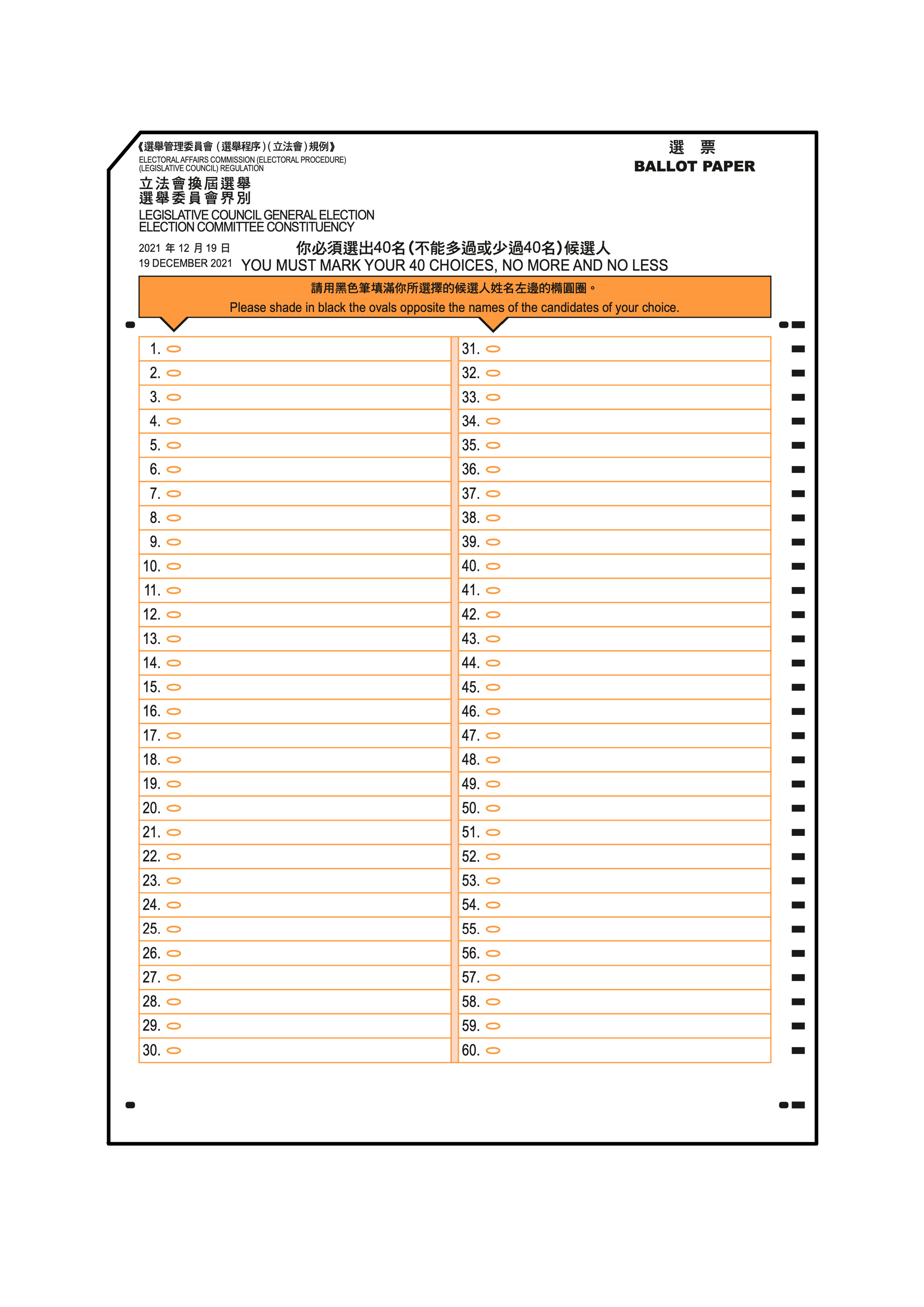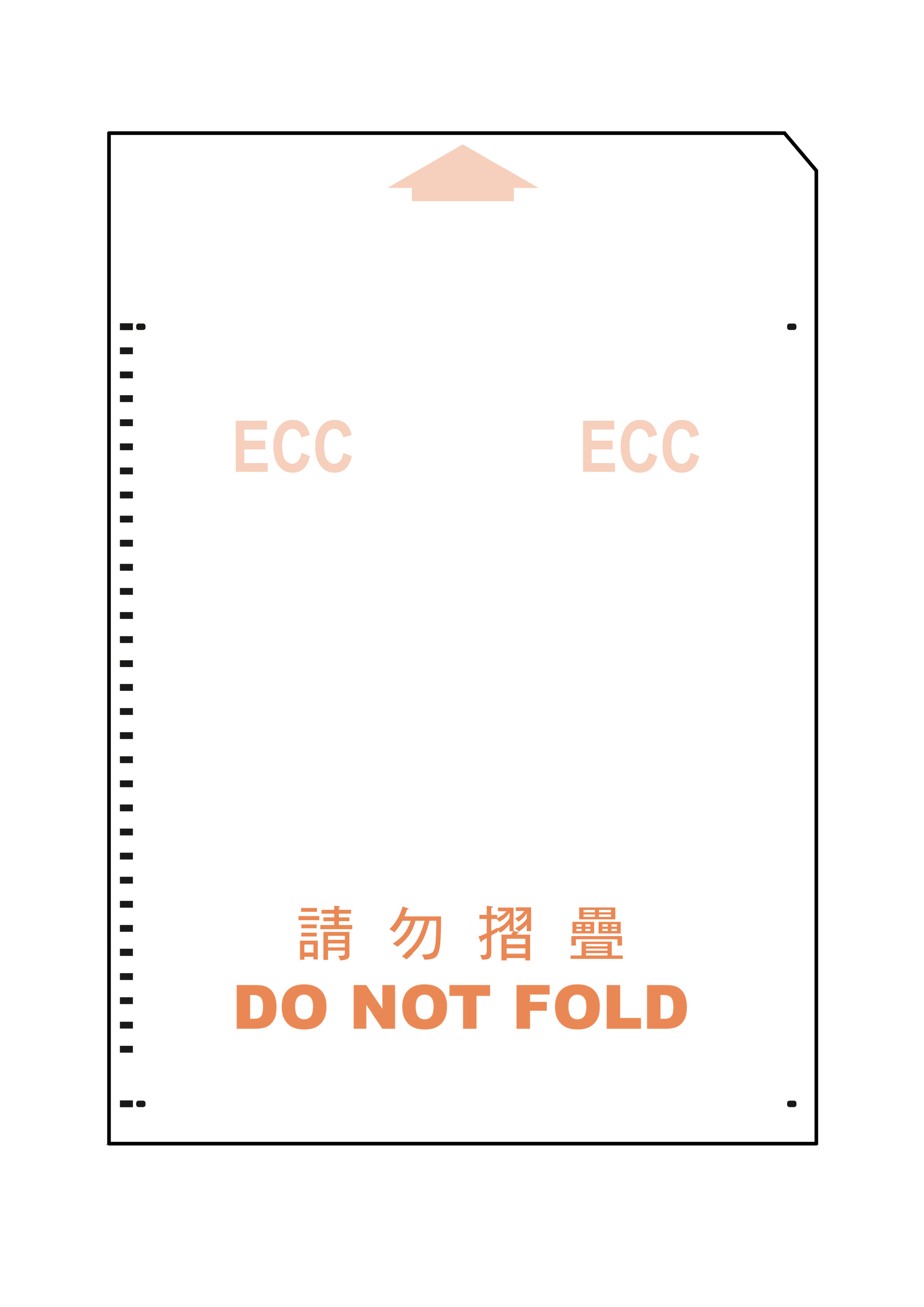Polling Information
Know Your Ballot Paper
- Election Committee Constituency (“ECC”)
Ballot Paper Checking and Vote Counting System for the Election Committee constituency
- Ballot Paper Checking and Vote Counting System (“BPCVCS”)
- Operation mechanism and advantages of the Optical Mark Recognition (“OMR”) technology
- Workflow for the use of OMR machines at the Central Counting Station (“CCS”)
- Independent quality assurance services
Ballot Paper Checking and Vote Counting System (“BPCVCS”)
Given the large number of seats and candidates for the Election Committee constituency (“ECC”) and similar to the arrangement for the Election Committee Subsector Ordinary Elections, the Registration and Electoral Office (“REO”) has commissioned a contractor to develop a Ballot Paper Checking and Vote Counting System (“BPCVCS”), whereby vote counting for the ECC will be conducted in an automated mode with the aid of Optical Mark Recognition (“OMR”) machines. In addition, under the electoral law, an elector voting for the ECC must vote for a number of candidates that is equal to the number of members to be returned for the ECC, i.e. no more or no less than 40 choices. Otherwise, it will render a ballot paper invalid and not to be counted. To assist an elector to check whether the number of candidates marked by him/her on the ballot paper is equal to the number of members to be returned for the ECC, ballot paper checking machines will be set up at the ECC polling station. The ballot paper checking machines will not record or count electors’ choices marked on their ballot papers. Whether or not an elector uses the checking machines is entirely voluntary.
The major components of the BPCVCS in respect of vote counting include:
| Components | Functions |
|---|---|
|
1. Custom Programs of the BPCVCS in respect of vote counting (“Custom Programs”) |
|
| 2. OMR machines |
|
| 3. Manual Key Entry (“MKE”) |
|
Operation mechanism and advantages of the OMR technology
- OMR is an optical technology using light beams to scan and capture data. After marking the designated areas on a form, the OMR technology will input the data into a computer system effectively and accurately in an automated mode, saving the tedious and repetitive manual efforts. In addition to reduction in operational cost, the chance of making mistakes during the manual input process can also be minimized significantly. Applications of the OMR technology include marking of multiple-choice examination papers, analysis of questionnaires and vote-counting for shareholders’ resolutions, etc.
- An OMR machine will convert the marked choices on a ballot paper into digital format that can be processed by a computer counting system. When scanning a ballot paper, the OMR machine will emit beams of light to the ovals opposite the names of candidates. Since the marked ovals will reflect less light beams, through recognizing and measuring the light reflected, the OMR machine can identify and capture the votes on a ballot paper. As far as vote counting is concerned, the custom programs of the system will integrate, count and then store the data into the central database.
Workflow for the use of OMR machines at the CCS
- After opening of ballot boxes, counting staff will conduct visual screening of each ballot paper.
- Clearly invalid ballot papers will not be counted whereas questionable ballot papers will be separated and forwarded to the RO to decide whether the votes are valid and should be counted. The remaining ballot papers, which are readable by the OMR machines, will be counted in an automated mode by the OMR machines at the Ballot Paper Scanning Zone. Ballot papers, which appear not readable or which are not accepted by the OMR machines, will be submitted to the RO for consideration.
- The validity of questionable ballot papers will be determined by the ROs at the Questionable Ballot Paper Determination Table in the presence of the candidates and their agents who are present. The determination result will also be announced there. The choices on the questionable ballot papers ruled valid by the RO will be counted by OMR machines or input to the vote-counting system manually at the MKE Zone.
- Data input by the OMR machines and MKE will be integrated and counted by the BPCVCS and then stored into the central database.
- Upon completion of the count, the RO will make known the initial counting result to the candidates and their agents who are present at the CCS. If there is no request for re-count by the candidates or their election agents, or the request is rejected by the RO, the RO will announce the election result on stage at the Media Centre.
Independent quality assurance services
As in past elections, the REO will ensure that the 2021 LCGE is conducted openly, fairly and honestly. Considering that the BPCVCS is a vital part of the election, the REO has commissioned three independent quality assurance services to safeguard the reliability of the system:
- Quality Assurance Services
- To conduct comprehensive testing on the programs of the BPCVCS, including function testing, system integration testing and load testing, etc.
- Computer Audit Services
- To provide a computer audit on the integrity of the ballot paper checking and the entire automated counting process to ensure that the BPCVCS complies with all relevant requirements, and monitor the integrity, security and accuracy of the data in the BPCVCS.
- To audit the test plans, test specifications and test results submitted by both BPCVCS Contractor and Quality Assurance Contractor, and offer advice where necessary.
- To monitor the whole counting process at the CCS.
- Information Technology Security Risk Assessment and Audit Services
- To provide an information technology security risk assessment and audit on the entire system, including access control, data security, application security, network and communication security, etc.
The contractors of the three independent quality assurance services have completed all pre-production testing on the BPCVCS. Final system testing on the BPCVCS will be conducted by the contractors at the CCS before its formal operation.


